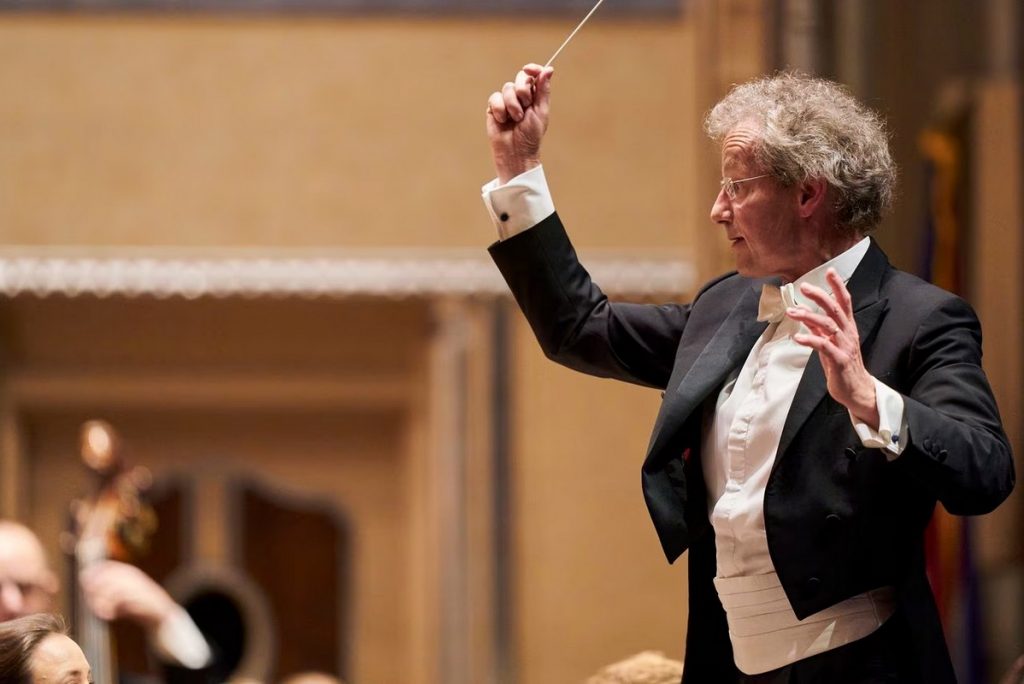Photo: Roger Mastroianni
This article was originally published on Cleveland.com
by Kevin McLaughlin
The world premiere of a percussion extravaganza stole the show on Thursday night in Mandel Hall at Severance Music Center, and may have set a record for the most percussion ever assembled on one stage.
Beginning the concert, Franz Welser-Möst’s account of Mozart’s Symphony No. 29 was airy and buoyant, despite larger-than-fashionable forces (42 strings). The outer movements were joyous and rhythmically meticulous, and the Orchestra’s ability to coalesce and balance was uncanny.
The title for Johannes Maria Straud’s new percussion concerto, Whereas the Reality Trembles, is a line from the poet William Carlos Williams, a favorite of the composer. A Cleveland Orchestra co-commission, some of the best moments of the work occurred in the twenty minutes or so it took for the stage crew to effect the setup.
In what looked like a parade of toys, they brought onstage every size and shape of terracotta flowerpots, imperfectly tuned cowbells, and pitched woodblocks — not to mention the beautiful arrays of sticks needed to strike them. The audience was appreciative, applauding even the preliminaries. The performance, featuring soloist Christoph Sietzen, was also spectacular.
Sietzen is a real showman, given to raising his arms high in the air, aggressively hitting his targets, running to and from instruments, even engaging in some audience banter when building the Frank Gehry-like structure that would be his trap set for the evening (“Every inch counts!” he yelled).
His playing was thrilling, not the least for his obvious commitment to this leviathan of a work, which he collaborated in bringing to life. Also amazing was the coordination of his part with the Orchestra’s percussion section — just as well-equipped, but with more helpers.
The work begins with a percussion-heavy Mission Impossible-sounding theme from the orchestra which served to goad the soloist to show what he could do. Xylophone and tuned crotales and woodblocks were his first targets. After every pitch and color had been explored with sticks, Sietzen used his fingers and hands.
Unusual effects in the orchestra became commonplace — brass in the highest register, harmonics in the bass clarinet, glissandi in the basses, clusters from the accordion, strummed piano strings — while the soloist also enlarged expectations (is this where “reality trembles”?). The range of sounds an electronic synthesizer produces seems narrow by comparison.
The ending was loud and frenetic, a volley of percussion and choreographed sound. Volume begat more volume, and then it was over. The audience rose amid shouts of adulation. The composer, looking pleased and exhausted, clambered his way over instruments for a group hug and bow.
The traditional nickname for Tchaikovsky’s Symphony No. 2 as — Little-Russian — appears to have been coined by critic Nikolay Kashkin because it included several folk tunes from Ukraine, then commonly known as “Little Russia.” For Ukranians the term is pejorative and condescending. A program note by Maria Sonevytsky makes a strong case for referring to the symphony as “Ukrainian,” as The Cleveland Orchestra does.
The opening tune is based on the Ukrainian version of the Russian folk song, Down along the Volga.” Played beautifully by principal horn Nathan Silberschlag, its calm nobility effectively drew a curtain between the two halves of the concert. Welser-Möst led the orchestra in a stately march in the Andantino marziale movement, based on the folksong, Keep on Spinning, My Spinner, letting low strings make the most of a counter melody.
Only the third-movement scherzo lacks authentic folk material, although the central Trio section bespeaks folk dance, suddenly shifting from triple to duple time. Despite Tchaikovsky’s tendency to repeat himself in the Finale, the music packed a punch. Reveling in the thrilling chorale on the Ukrainian tune The Crane, Welser-Most let national pride and triumph have the last word.
Published on ClevelandClassical.com October 9, 2023.
Click here for a printable copy of this article
Return to the Front Page.




